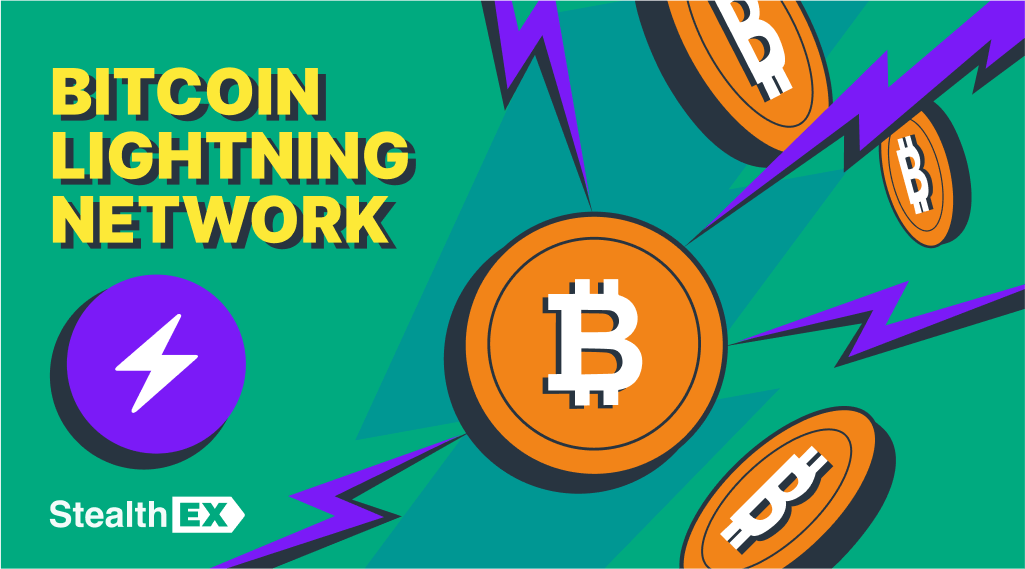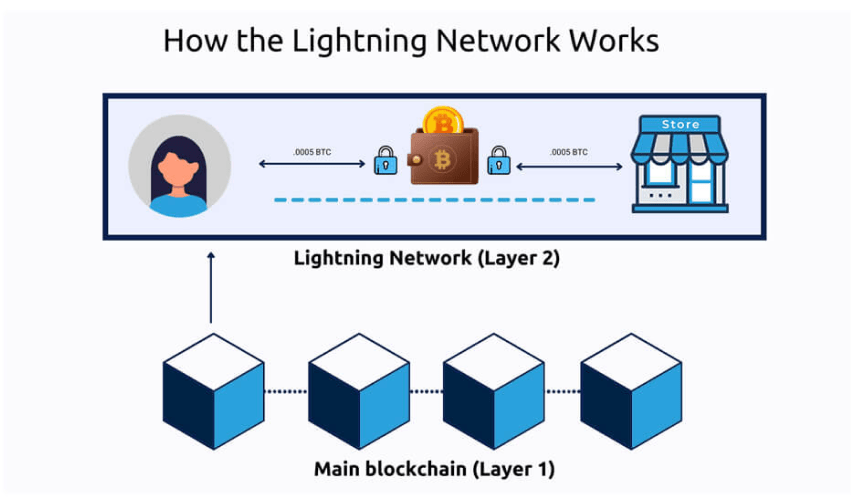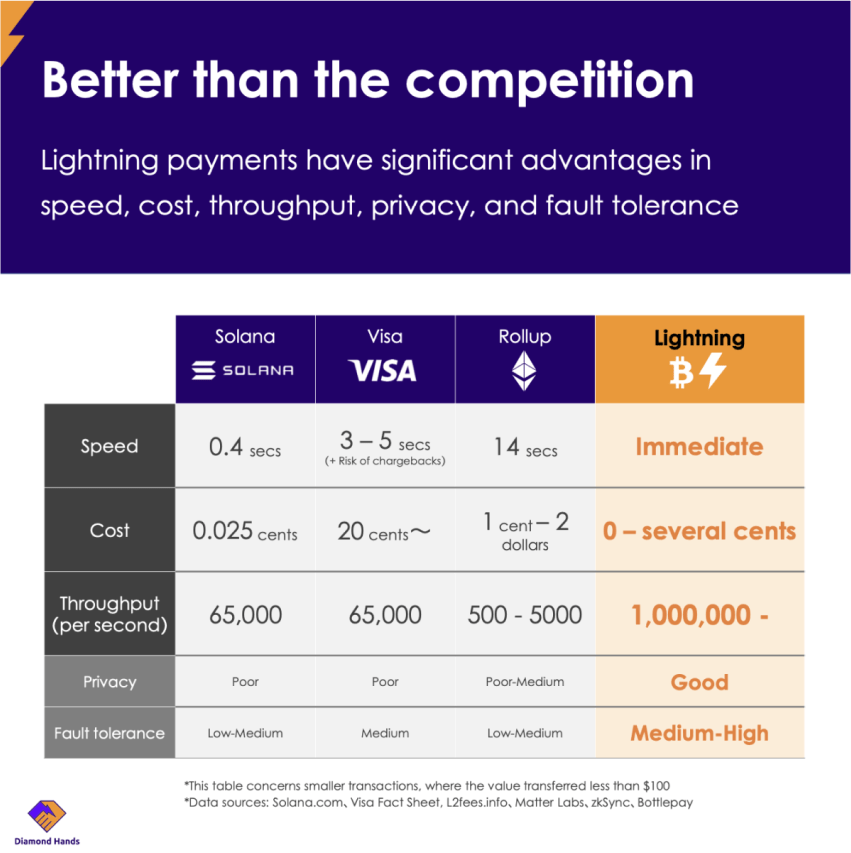Bitcoin Lightning Network: A Breakthrough in Cryptocurrency Scalability

Bitcoin, the pioneer of cryptocurrencies, faces a scalability challenge. As its popularity surged, so did transaction times and fees. Enter the Lightning Network: a second-layer solution designed to supercharge Bitcoin transactions. This network promises faster speeds and minimal fees. Let’s explore how it aims to revolutionize Bitcoin’s scalability.

Article contents
- 1 Understanding the Lightning Network: How It Works?
- 2 Real-world Use Cases
- 3 Industry Insights
- 4 Conclusion
- 5 FAQ: Bitcoin Lightning Network Explained
- 5.1 What Is the Lightning Network?
- 5.2 How Does the Lightning Network Improve Transaction Speeds?
- 5.3 Are Transactions on the Lightning Network Cheaper?
- 5.4 What Are Payment Channels in the Lightning Network?
- 5.5 Is the Lightning Network Fully Decentralized?
- 5.6 What Are the Primary Challenges of the Lightning Network?
- 5.7 How Does the Lightning Network Handle Cross-border Payments?
- 5.8 What Is the “Streaming Money” Concept in the Lightning Network?
- 5.9 How Does the Lightning Network Compare to Other Scalability Solutions?
- 5.10 Is the Lightning Network Widely Adopted?
Understanding the Lightning Network: How It Works?
The Lightning Network isn’t just a fancy term; it’s a sophisticated system designed to address Bitcoin’s inherent limitations. Introducing a second layer atop the Bitcoin blockchain offers a new way to transact that’s faster and more efficient. Here’s how it works:
The Lightning Network operates atop the Bitcoin blockchain but doesn’t record every transaction. Instead, it uses off-chain payment channels, allowing multiple transactions without blockchain confirmation each time. Only when the channel closes does it settle the net amount on the blockchain.
To start transacting, two parties open a payment channel by creating a multi-signature wallet, which requires signatures from both parties for transactions. They then deposit a certain amount of Bitcoin into this wallet. They update their respective balances as they transact, keeping a record off-chain. When they’re done transacting, they close the channel, and the final balance gets recorded on the Bitcoin blockchain.
The beauty of the Lightning Network lies in its interconnected channels. If Alice has a channel with Bob and Bob has one with Charlie, Alice can pay Charlie through Bob without needing a direct channel. Nodes in the network help in routing these payments, ensuring they find the shortest and cheapest path.

Source: Antier Solutions
Benefits of the Lightning Network
The Lightning Network isn’t just about speed; it’s a comprehensive solution that benefits the Bitcoin ecosystem. By addressing some of the core challenges the traditional Bitcoin network faces, the Lightning Network paves the way for a more efficient and user-friendly transaction experience. Here are its standout advantages:
- Speedy Transactions – One of the most touted advantages of the Lightning Network is its ability to process transactions at lightning speed. Unlike the traditional Bitcoin network, where transactions take 10 minutes to several hours, the Lightning Network facilitates instant transactions. This is because it bypasses the need for block confirmations for every transaction, making microtransactions and frequent trading more feasible.
- Lower Transaction Fees – High transaction fees have been a significant pain point for Bitcoin users. The Lightning Network addresses this by reducing the need to record every transaction on the main blockchain. With fewer data to process and validate, transaction fees plummet. This makes it faster but also more cost-effective, especially for small transactions.
- Enhanced Scalability – Bitcoin’s scalability issue arises from its block size limit and the time taken for block confirmations. The Lightning Network sidesteps this by handling most transactions off-chain. As a result, the main Bitcoin blockchain remains uncluttered, ensuring smoother and more scalable operations. This approach can support millions of transactions per second, a significant leap from Bitcoin’s current capacity.
Challenges and Criticisms
While the Lightning Network offers promising solutions, it has challenges. As with any emerging technology, there are hurdles and criticisms to address. Let’s delve into some of the primary concerns:
- Liquidity Concerns – For the Lightning Network to function smoothly, channels need sufficient liquidity. If a channel lacks the necessary funds, a transaction might fail or require a longer route, leading to higher fees. This can be especially problematic for larger transactions, which might need help finding a suitable path through the network.
- Centralization Risks – One of the core principles of cryptocurrencies is decentralization. However, the Lightning Network may inadvertently promote centralization. Larger nodes with more liquidity could become central hubs, leading to a network topology where a few nodes control a significant portion of the transactions, potentially undermining Bitcoin’s decentralized ethos.
- Technical Barriers – The Lightning Network, while revolutionary, is technically complex. Setting up and maintaining nodes, channels, and ensuring network security can be daunting for the average user. This complexity might deter mainstream adoption unless user-friendly solutions emerge.
Choose StealthEX for Exchange and Buy Crypto
- User-Friendly — Simple and minimalistic interface for everyone.
- Fast and Private — Instant non-custodial cryptocurrency exchanges.
- Buy crypto with Credit Card.
- 1400+ coins and tokens are available for limitless, quick and easy exchanges.
- NO-KYC crypto exchanges — Buy cryptocurrency up to €700 without KYC!
- StealthEX crypto exchange app — Process crypto swaps at the best rates wherever you are.
- 24/7 Customer Support.
Earn from Each Exchange by Joining StealthEX Affiliate Program.
Become a partner right now and use affiliate tools:
- Public API — Earn from your wallet, aggregator, or exchange terminal.
- Referral Links — Recommend StealthEX to your audience.
- Exchange Widget — Built crypto exchange widget on any page of your website.
- Button — A perfect choice for traffic monetization.
- Banner — Track conversion and stats right in the personal cabinet.
Real-world Use Cases
The theoretical advantages of the Lightning Network are evident, but its real value shines through in practical applications. Across the globe, users and businesses are leveraging its capabilities for various purposes. Here’s a glimpse into some compelling use cases:
Microtransactions
Traditional payment systems often make small transactions uneconomical due to fees. With the Lightning Network’s minimal fees, microtransactions become viable. This opens doors for content creators to charge minuscule amounts for content access or for online games to facilitate small in-game purchases.
Cross-border Payments
Sending money across borders can be slow and expensive with traditional banking systems. The Lightning Network offers a faster, cheaper alternative. Users can send Bitcoin globally in seconds, bypassing bureaucratic hurdles and exorbitant fees.
Streaming Money Concept
Imagine paying for a service by the second or minute, like streaming a movie, and only paying for the exact duration you watched. The Lightning Network makes this “streaming money” concept possible, allowing for dynamic, ongoing payments without constant transaction confirmations.
Industry Insights
The Lightning Network’s emergence has stirred discussions and debates within the crypto community. Let’s explore what industry experts say and how it compares to other scalability solutions.
Many industry leaders view the Lightning Network as a game-changer for Bitcoin. They believe it addresses core scalability issues, making Bitcoin more competitive with traditional payment systems. However, some experts express concerns about its technical complexity and potential centralization, emphasizing the need for ongoing development and refinement.
Moreover, the Lightning Network isn’t the only scalability solution in town. Alternatives like sidechains, state channels, and sharding have been proposed for various blockchains. While each has its merits, the Lightning Network stands out for its focus on Bitcoin and its unique approach to off-chain transactions. It offers a balance of speed, security, and decentralization, making it a leading contender in the race to scale Bitcoin.

Source: Bitcoin Magazine
Conclusion
The Lightning Network, with its innovative approach to scalability, holds immense promise for Bitcoin’s future. Addressing key challenges like transaction speed and fees paves the way for broader adoption of Bitcoin as not just a store of value, but also a medium of exchange. However, like all pioneering technologies, it faces challenges and criticisms. The crypto community’s collaborative spirit and ongoing research and development will likely steer the Lightning Network towards its full potential.
As we reflect on its implications, one thing is clear: the Lightning Network could play a pivotal role in shaping the future of the broader crypto ecosystem.
FAQ: Bitcoin Lightning Network Explained
What Is the Lightning Network?
The Lightning Network is a second-layer solution designed to enhance Bitcoin’s scalability and transaction speed. It operates atop the Bitcoin blockchain, allowing for faster, off-chain transactions that settle on the main blockchain only when necessary.
How Does the Lightning Network Improve Transaction Speeds?
By using off-chain payment channels, the Lightning Network bypasses the need for block confirmations for every transaction. This facilitates almost instantaneous transactions, a stark contrast to the traditional Bitcoin network’s wait times.
Are Transactions on the Lightning Network Cheaper?
Yes, the Lightning Network significantly reduces transaction fees. Since most transactions occur off-chain and don’t require blockchain validation, the associated costs plummet, making it especially cost-effective for microtransactions.
What Are Payment Channels in the Lightning Network?
Payment channels are private pathways between two parties that allow them to transact multiple times without recording each transaction on the blockchain. Only the net result gets settled on the blockchain when the channel closes.
Is the Lightning Network Fully Decentralized?
While the Lightning Network aims to maintain Bitcoin’s decentralized ethos, there are concerns about potential centralization. Larger nodes with more liquidity might become dominant, leading to a few nodes controlling a significant portion of the transactions.
What Are the Primary Challenges of the Lightning Network?
The main challenges include ensuring sufficient liquidity in channels, potential risks of centralization, and the technical complexity of setting up and maintaining the network.
How Does the Lightning Network Handle Cross-border Payments?
The Lightning Network offers a swift and affordable solution for cross-border transactions. Users can send Bitcoin globally in seconds, avoiding the delays and high fees associated with traditional banking systems.
What Is the “Streaming Money” Concept in the Lightning Network?
“Streaming money” refers to the ability to make dynamic, ongoing payments, like paying for a service by the exact duration used. The Lightning Network’s low fees and fast transactions make this concept feasible.
How Does the Lightning Network Compare to Other Scalability Solutions?
While there are other scalability solutions like sidechains and sharding, the Lightning Network is unique in its focus on Bitcoin and its approach to off-chain transactions. It offers a balance of speed, security, and decentralization.
Is the Lightning Network Widely Adopted?
The Lightning Network is gaining traction, with increasing adoption by businesses and users. Its benefits of faster transactions and lower fees make it an attractive solution for many in the crypto community.
Follow us on Medium, Twitter, Telegram, YouTube, and Publish0x to stay updated about the latest news on StealthEX.io and the rest of the crypto world.
Don’t forget to do your own research before buying any crypto. The views and opinions expressed in this article are solely those of the author.
Bitcoin Bitcoin Lightning Network BTC crypto world Lightning NetworkRecent Articles on Cryptocurrency
 Pudgy Penguins Price Prediction: Is PENGU Coin a Good Investment?
Pudgy Penguins Price Prediction: Is PENGU Coin a Good Investment?  Celestia Price Prediction: Will TIA Coin Reach $10?
Celestia Price Prediction: Will TIA Coin Reach $10? 